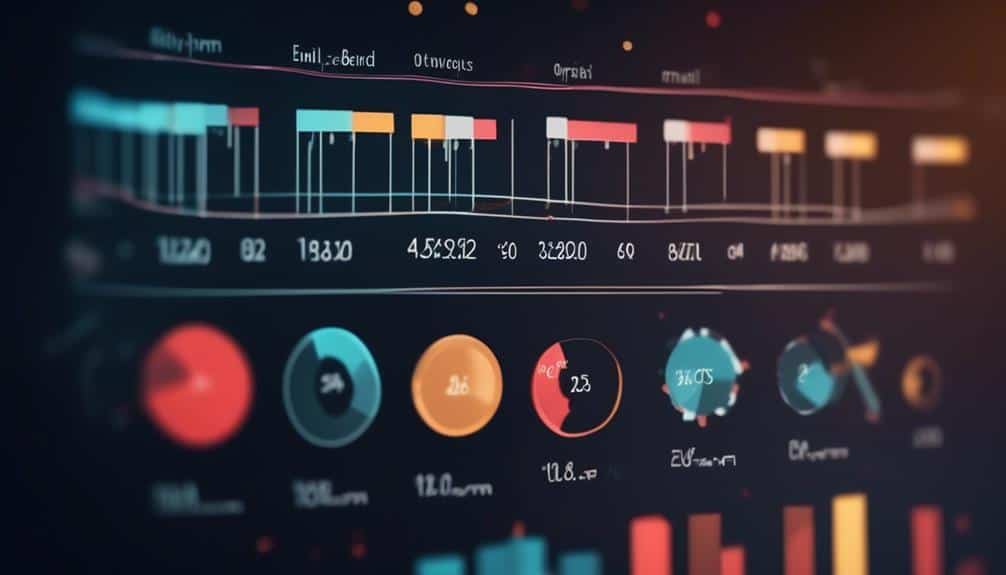Quick Action Needed: Unveil the Secrets to Seamless Email Automation Today
Are you tired of spending hours manually sending out individual emails to your subscribers?
Imagine if you could automate your email campaigns and reach your audience at the right time with the right message.
Picture this: a business owner who implemented email automation saw a 40% increase in open rates and a 25% boost in click-through rates. Intriguing, isn't it?
Well, the secrets to achieving seamless email automation are within your grasp, but quick action is needed.
In this discussion, we will explore the benefits, key strategies, and advanced techniques that will empower you to take your email marketing to the next level.
So, are you ready to revolutionize your email campaigns and unlock the full potential of automation?
Key Takeaways
- Email automation significantly improves efficiency and effectiveness of campaigns.
- Choosing the right email automation software involves evaluating requirements, researching and comparing options, considering scalability, and implementing best practices.
- When selecting email automation software, it's important to evaluate specific needs and goals, conduct thorough comparisons, consider scalability and user reviews, and choose software that supports personalization, segmentation, and analytics.
- Setting up an email automation workflow involves defining goals, segmenting the audience, mapping out the customer journey, delivering personalized content, and saving time while delivering personalized experiences.
Benefits of Email Automation

When it comes to streamlining your email marketing efforts and maximizing your results, email automation offers a multitude of benefits. Email automation case studies have shown that it can significantly improve the efficiency and effectiveness of your email campaigns. For small businesses, email automation is a game-changer as it allows you to deliver personalized and timely messages to your customers, without the need for manual intervention.
One of the key benefits of email automation is its ability to save you time and resources. By automating repetitive tasks such as sending welcome emails, birthday wishes, or abandoned cart reminders, you can free up your time to focus on other important aspects of your business. Not only does this increase efficiency, but it also ensures that your customers receive timely and relevant communications, leading to higher engagement and conversion rates.
Moreover, email automation allows you to segment your audience based on their behavior, preferences, and demographics. By sending targeted messages to specific segments, you can deliver more personalized and relevant content, which in turn leads to higher open and click-through rates. This level of personalization not only enhances the customer experience but also helps you build stronger relationships with your audience.
Choosing the Right Email Automation Software
When it comes to choosing the right email automation software, there are several key factors to consider.
First, you'll want to evaluate the software selection tips that can help you make an informed decision.
Then, it's important to identify the key features that are essential for your specific business needs.
Lastly, implementing best practices will ensure a smooth transition and maximize the benefits of your chosen email automation software.
Software Selection Tips
To choose the right email automation software, consider the specific needs and goals of your business. Here are some software selection tips to help you make an informed decision:
- Evaluate your requirements: Determine what features and functionalities are essential for your email automation needs. Consider factors like email personalization, segmentation, and analytics.
- Research and compare: Conduct a thorough email automation comparison to identify the software that aligns with your requirements. Look for user reviews, ratings, and case studies to gauge the software's effectiveness.
- Consider scalability: Choose a software that can accommodate your business's growth. Ensure it can handle a large volume of emails and support additional features as your needs evolve.
Key Features to Consider
To choose the right email automation software for your business, it's crucial to consider the key features that will drive your email marketing success.
When evaluating email automation tools, look for features that can streamline your workflow and improve your overall efficiency. For example, consider software that offers advanced segmentation capabilities, allowing you to target specific customer groups with personalized content.
Look for tools that provide detailed analytics and reporting, enabling you to track the effectiveness of your email campaigns and make data-driven decisions.
Additionally, seek software that supports A/B testing, allowing you to experiment with different email automation examples and optimize your campaigns for better results.
Implementation Best Practices
Choose the email automation software that best aligns with your business goals and maximizes your email marketing success. To ensure a seamless implementation, follow these best practices:
- Research and compare different email automation software options to find the one that fits your specific needs.
- Consider the scalability of the software to accommodate your future growth.
- Look for a user-friendly interface that allows you to easily create and manage email campaigns.
Common mistakes to avoid when implementing email automation software include:
- Neglecting to define clear goals and objectives for your email marketing campaigns.
- Failing to segment your email list and personalize your messaging.
- Overlooking the importance of monitoring and analyzing campaign performance.
Setting Up Your Email Automation Workflow
Optimize your email automation workflow to maximize efficiency and engagement. Setting up your email automation workflow is a critical step to ensure the success of your email marketing campaigns. By implementing a well-designed workflow, you can harness the power of automation to save time, increase productivity, and deliver personalized experiences to your subscribers.
To begin, define the goals you want to achieve through email automation. Whether it's nurturing leads, driving sales, or improving customer retention, clearly outlining your objectives will guide the structure of your workflow.
Next, segment your audience based on their preferences, behaviors, and demographics. This allows you to tailor your messages to specific groups, increasing relevance and engagement. By utilizing the data collected from your subscribers, you can deliver personalized content that resonates with each individual.
Once you have segmented your audience, map out the customer journey. Identify the touchpoints where you want to engage with your subscribers and determine the appropriate automation triggers. These triggers could include actions such as website visits, email opens, or specific behaviors.
Effective Strategies for Personalization in Email Automation

Now let's explore powerful techniques to personalize your email automation and boost engagement with your subscribers.
- Segmentation: Divide your subscriber list into smaller segments based on their demographics, interests, or behavior. This allows you to tailor your emails to specific groups, increasing relevance and engagement.
- Dynamic Content: Use dynamic content in your emails to deliver personalized messages based on subscriber data. By dynamically inserting names, locations, or purchase history, you can create a more personalized experience, making subscribers feel valued and understood.
- Behavioral Triggers: Set up automated emails triggered by specific actions, such as abandoned carts or recent purchases. This allows you to send timely and relevant emails that resonate with your subscribers, increasing the chances of conversion.
Optimizing Email Deliverability in Automated Campaigns
To ensure that your automated email campaigns reach their intended recipients and maximize engagement, it's crucial to focus on optimizing email deliverability. With the increasing reliance on email as a communication channel, it's essential to understand the best practices for email deliverability and how it can impact the success of your automated campaigns.
One of the first steps in optimizing email deliverability is to choose the right email automation tool. Conducting an email automation tools comparison will help you select a platform that offers robust deliverability features, such as spam filters, bounce management, and reputation monitoring.
In addition to selecting the right tool, there are several best practices you should follow. First, ensure that your email list is clean and up-to-date. Regularly remove inactive or unengaged subscribers to maintain a high-quality list.
Second, personalize your emails and avoid generic or spammy content. Tailor your messages to the recipient's preferences and behavior to increase open and click-through rates.
Furthermore, it's crucial to monitor and analyze your email deliverability metrics. Track your email open rates, click-through rates, and bounce rates to identify any issues and make necessary adjustments to your campaigns.
Measuring Success With Email Automation Metrics

Measuring the success of your email automation campaigns is essential for optimizing your strategies and achieving your goals. To ensure that you're on the right track, it's important to have a clear understanding of the key metrics that you should be tracking.
Here are three important metrics to consider when measuring the success of your email automation campaigns:
- Open Rate: This metric measures the percentage of recipients who open your emails. A high open rate indicates that your subject lines are engaging and compelling, while a low open rate may suggest that you need to work on improving your subject lines.
- Click-Through Rate (CTR): The CTR measures the percentage of recipients who click on the links in your emails. A high CTR indicates that your content is relevant and engaging, while a low CTR may suggest that you need to improve your content or call-to-action.
- Conversion Rate: The conversion rate measures the percentage of recipients who take the desired action, such as making a purchase or signing up for a newsletter. A high conversion rate indicates that your emails are effective in driving the desired actions, while a low conversion rate may suggest that you need to optimize your emails or landing pages.
Advanced Tips and Tricks for Email Automation Mastery
Looking to take your email automation campaigns to the next level? Here are some advanced tips and tricks to help you master the art of email automation. One of the biggest challenges in email automation is ensuring seamless integration with your existing systems. To overcome this challenge, it is essential to choose an email automation platform that offers easy integration with your CRM, e-commerce platform, and other tools you use. This will allow you to automate tasks and sync customer data effortlessly.
Another challenge is maintaining a high deliverability rate. To improve your deliverability, make sure to regularly clean your email lists and segment your audience based on their interests and behaviors. This will help you send targeted and relevant emails, increasing engagement and reducing the chances of your emails landing in spam folders. Additionally, optimizing your email content for mobile devices is crucial, as the majority of people now check their emails on smartphones.
Here are some advanced tips and tricks for email automation mastery:
| Tip | Explanation | Benefits |
|---|---|---|
| Personalize your emails | Tailor your emails to individual recipients to increase engagement and conversions. | Higher open and click-through rates |
| Use dynamic content | Insert dynamic content like product recommendations or personalized offers based on user behavior. | Improved relevancy and higher conversion rates |
| A/B test your campaigns | Experiment with different subject lines, email designs, and call-to-action buttons to optimize your campaigns. | Increased effectiveness and better understanding of your audience |
| Set up triggered emails | Create automated emails triggered by specific actions or events, such as abandoned carts or welcome emails. | Enhanced customer experience and increased conversions |
| Monitor and analyze metrics | Track key metrics like open rates, click-through rates, and conversion rates to measure the success of your campaigns. | Insights for optimization and continuous improvement |
Frequently Asked Questions
What Are the Potential Drawbacks or Challenges of Implementing Email Automation?
Implementing email automation can have potential drawbacks or challenges. However, with the right solutions and best practices, you can overcome these obstacles and achieve seamless automation that serves your audience effectively.
How Does Email Automation Impact Open Rates and Click-Through Rates?
Email automation versus manual sending can have a significant impact on open rates and click-through rates. Personalized email automation allows for tailored messaging, leading to higher engagement and better results for your business. Embrace the benefits of automation today!
Can Email Automation Be Used for Lead Nurturing and Customer Onboarding?
Email automation can greatly benefit lead nurturing and customer onboarding. It allows for personalized and timely communication, increasing engagement and conversions. Utilize email automation for e-commerce and event promotion to maximize your results.
Are There Any Industry-Specific Best Practices for Email Automation?
For effective email automation in different industries, industry-specific strategies and best practices are key. Tailoring your emails to the needs and preferences of your audience will ensure seamless automation and successful engagement.
What Are Some Common Mistakes to Avoid When Setting up an Email Automation Workflow?
When setting up your email automation workflow, common mistakes to avoid include: not segmenting your audience properly, sending too many emails too frequently, neglecting to personalize content, and failing to test and optimize your campaigns.
Conclusion
In conclusion, implementing email automation is essential for businesses looking to streamline their communication processes and increase efficiency. By choosing the right software, setting up a well-designed workflow, personalizing content, optimizing deliverability, and measuring success with relevant metrics, businesses can achieve remarkable results.
With advanced tips and tricks, mastering email automation becomes even more achievable. Don't miss out on the opportunity to unlock the secrets to seamless email automation and take your business to new heights.








